Staci doing thinning on her mom’s property in Sapello
Staci Matlock serves as the Public Information Specialist at the New Mexico Forest and Watershed Restoration Institute (NMFWRI), based at New Mexico Highlands University in Las Vegas, NM. For over two years, she has been an active leader in our FACNM Network. Through her professional work related to areas such as forest thinning, erosion control, and defensible space, Staci has made significant contributions to the exchange of knowledge and best practices within the Network.
Below, Staci shares some of her experiences and key takeaways from building fire-adapted communities and being part of the FACNM Network.
Q: Describe a life experience that helped shape your dedication and/or passion for your current work in building fire adapted communities.
A: The first home burned in the Hermit’s Peak fire belonged to a friend and colleague. By the time the Hermit’s Peak joined with Calf Canyon and swept across the landscape, it had burned the homes of four of my fellow volunteer firefighters with the Sapello-Rociada-San Ignacio fire district. While I spent decades covering fire, forests and public lands as a reporter, this devastating fire was the most up close and personal. It was followed a year later by Las Tusas fire, which came within ¼ mile of my mom’s house. Both drove home the need to prepare forests and communities for frequent and larger fires.
Q: When you think about your work in wildfire preparedness, what is your vision for your community?
A: In my role with NMFWRI, I understand the need for returning beneficial fire to our historically fire-adapted forests. Seeing the devastation from catastrophic wildfires firsthand drives my desire to help communities adapt to living with fire and help restore beneficial fire to the landscape.
Q: What are one or two projects, partnerships, or efforts you’re especially proud of?
A: NMFWRI has many excellent partners at the local and state level. New ones developed and strengthened during the HPCC fire, such as those with landowners and the local soil and water conservation district along with the Wildfire Resiliency Training Center at Luna CC. The land restoration and structural ignition workshops coordinated by my colleague Shantini Ramakrishnan and the “Querencia in Action” landowner guides we are publishing are helping promote pre- and post-fire work in communities.
Querencia in Action workshop on using burned trees for log mat erosion control
Q: What challenges or barriers have you faced in your work, and how have you worked through them?
A: It can be challenging to promote fire mitigation and beneficial fire in an area that has already been impacted by a major wildfire and to people who either don’t have the resources to do mitigation work or are second home and absentee owners who aren’t vested in doing the work.
Q: How has being a part of the FACNM Network supported or shaped your work?
A: It has been great to hear about the work, events, and fire mitigation approaches by people in other communities.
Q: What advice would you give to someone stepping into a similar role or just beginning this work?
A: Find a small, like minded group to start with and build from there. And definitely involve local volunteer fire departments in events, trainings, and outreach for fire-adaption/mitigation.


